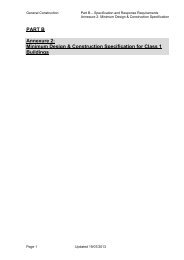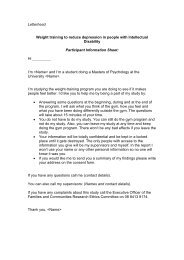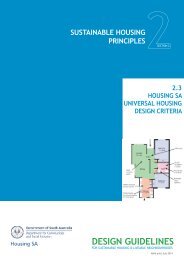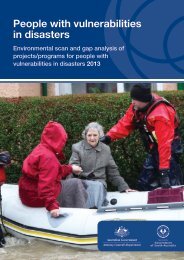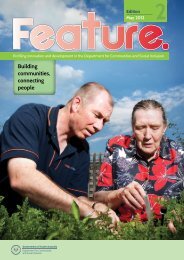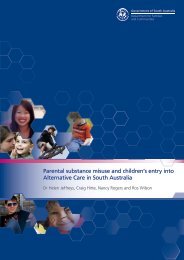Panyappi Indigenous Youth Mentoring Program Evaluation
Panyappi Indigenous Youth Mentoring Program Evaluation
Panyappi Indigenous Youth Mentoring Program Evaluation
You also want an ePaper? Increase the reach of your titles
YUMPU automatically turns print PDFs into web optimized ePapers that Google loves.
<strong>Panyappi</strong> <strong>Indigenous</strong> <strong>Youth</strong> <strong>Mentoring</strong> <strong>Program</strong> <strong>Evaluation</strong><br />
understood that participation in the evaluation would be voluntary and something that<br />
participants felt good about doing because they were clear about the purpose. It was<br />
also acknowledged that people may decline because they had other priority issues or the<br />
evaluation may be experienced as intrusive.<br />
In order for the evaluation to be respectful of cultural protocols and practices, and to<br />
address the cultural accountability of the non-<strong>Indigenous</strong> evaluation consultant, an<br />
<strong>Indigenous</strong> cultural advisor was engaged to guide all stages of the evaluation. Through<br />
this arrangement many issues were addressed, such as how to introduce the evaluation<br />
to young people and families working with <strong>Panyappi</strong>, and who was appropriate to conduct<br />
interviews based on <strong>Indigenous</strong> or non-<strong>Indigenous</strong> identity and then cultural connections<br />
of the cultural advisor and evaluation participants.<br />
The evaluation introduction occurred in three layers. Due to connections and existing<br />
relationships with families as the Coordinator, Lisa Kambouris was instrumental in<br />
facilitating this process. In the initial stages of the evaluation she spoke to all young<br />
people and families currently engaged with <strong>Panyappi</strong> to explain why they were evaluating<br />
the program and the possibility of being involved. She also ensured that mentors were<br />
thoroughly briefed on the evaluation. Through this she identified who was interested in<br />
knowing more and potentially being an evaluation participant.<br />
Following ethics approval for the evaluation plan, a social gathering was held at <strong>Panyappi</strong><br />
for interested families and young people. They met the evaluation consultant and<br />
<strong>Indigenous</strong> cultural advisor, gained information on the evaluation plan and process, and<br />
also received a written version of this. They had the opportunity to ask questions or just<br />
talk with the evaluators during the gathering, either during the meeting or over lunch.<br />
Some families and young people decided to participate at that point, while others agreed<br />
or withdrew interest later in conversation with Lisa. Other families who were unable to<br />
make the gathering were offered the opportunity to meet or speak separately with the<br />
evaluators, and several agreed to be part of the evaluation.<br />
<strong>Evaluation</strong> participants and methods<br />
The people or groups outlined in the Table 1 were included in the evaluation using the<br />
methods (program funders were included through the Advisory Group and the Senior<br />
Project Officer, Crime Prevention Unit, AGD).<br />
The evaluation methods were designed to gain in-depth qualitative data to build a picture<br />
of the experiences and outcomes of the participants’ involvement in <strong>Panyappi</strong> (in<br />
whatever capacity) and their opinions of the cultural appropriateness of the project’s<br />
model of mentoring. These methods use narrative or story as the primary mode,<br />
particularly for the interviews with young people, family members and Mentors, as<br />
narrative has a cultural fit for <strong>Indigenous</strong> people. Interviews and focus groups were<br />
audiotaped with the consent of participants.<br />
- 31 -



